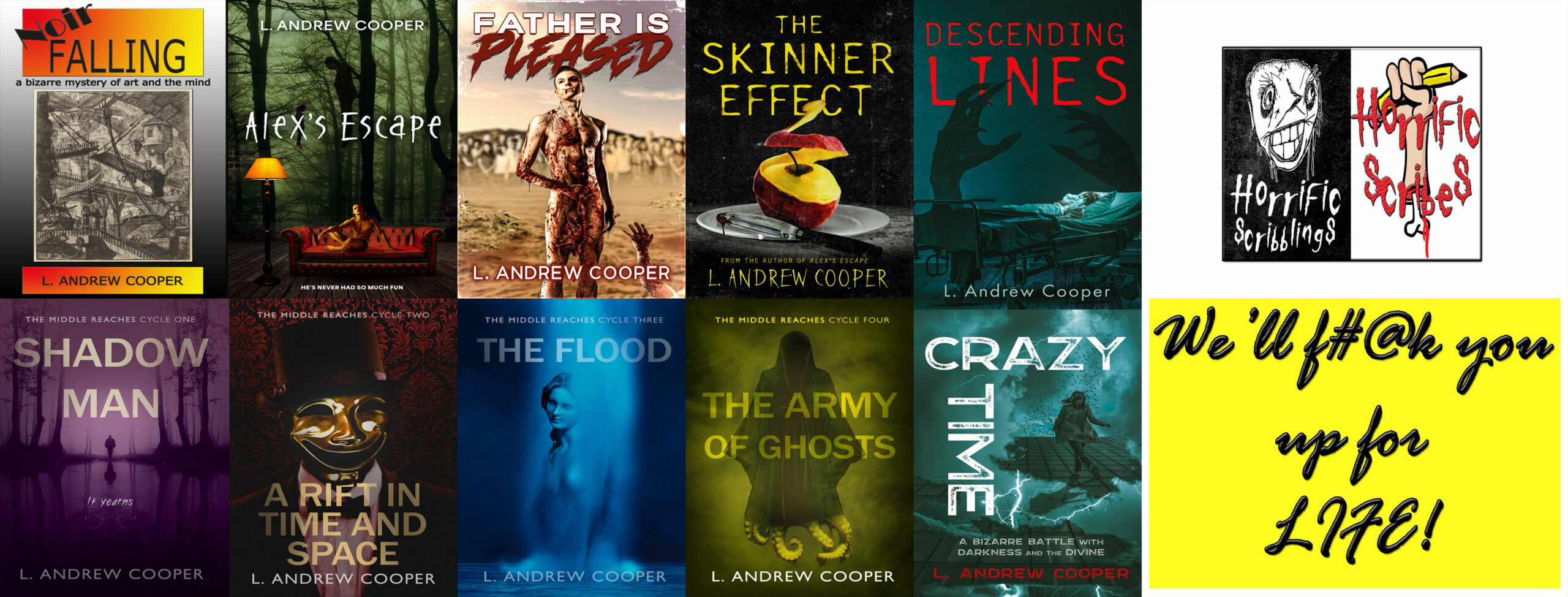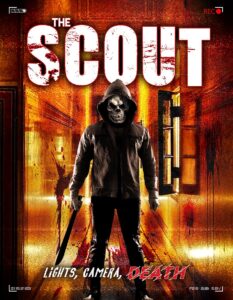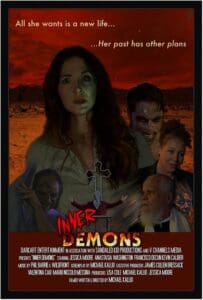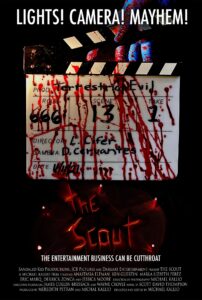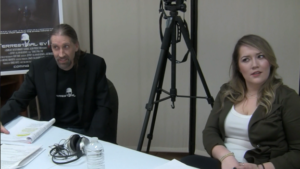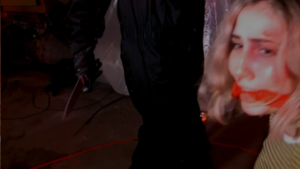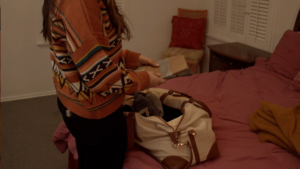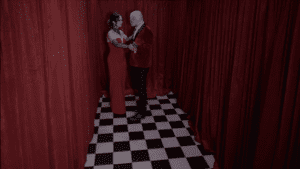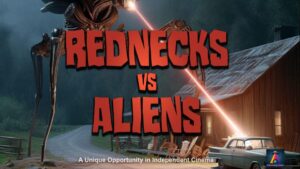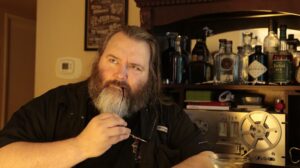Interview with Filmmaker Michael Kallio: The Scout, Inner Demons, and More (2024)
Michael Kallio, a unique combination of experimental filmmaker and crowd-pleaser, reveals the thinking behind his magic as we discuss a few of his films.
The Scout
An independent film crew on a group location scout are attacked by a mysterious masked killer, who appears “hell-bent” on murdering them one by one. Think Scream 3 and Waiting for Guffman meets The Office with more blood… LOL.
Inner Demons
After a near death experience, a woman with a troubled past is tortured by visions and hallucinations as she fears she has brought something back with her from the afterlife. The woman becomes terrified her “inner demons” will take control to the point of no return. Is it too late to save her own soul? An ode to the creepy, atmospheric horror films Carnival of Souls and Jacob’s Ladder, with a smidgen of Drag Me to Hell and Evil Dead thrown in.
The Interview
1. Financing Horrors. In our correspondence, you mentioned the ultra-low budgets of some of your films. How do you make such watchable movies with such low price tags? At what point do you start considering budget—the first time you jot down an idea, or at some other point in the process? What advice do you have for other writer-producer-directors working on shoestrings? To what extent does The Scout spoof as well as showcase low-budget restrictions?
MK: I’m glad you thought they were WATCHABLE… LOL. In all seriousness, thank you. I am glad you liked both The Scout and Inner Demons. Making a movie can be very tricky, so I am always pleased when people enjoy them.
To answer your first question, you do what you can with what you have… meaning, I take the budget into consideration before I really start writing. I had been considering doing a micro/no budget movie before I was approached to do The Scout back in 2020. When I read the initial script written by Anthony Leone, knowing the budget would be less than a crappy used car, I had ideas and really began breaking down the challenges I would face having little to no money. Before The Scout, I was trying to come up with an idea I was really interested in making, but it also had to be something I COULD do with nothing.
I hadn’t come up with anything at the time I was asked to direct The Scout, so the script was a good jumping-off point. I was able to re-write and fashion the script to locations I could get for free or reasonably cheap, actors who were willing to take the plunge, and enough effects/action/things to keep the audience satisfied for the type of film it was. I had figured out that if the movie looks bigger than it actually is (meaning cool, already art directed looking locations), good acting, and effects that were fun and messy and all the things people who like movies with special effects expect, then I thought I could do something fun, cool and entertaining.
First and foremost, the key is a decent script. I did the best I could with the rewrite and limited time frame for The Scout. I was on a deadline to have the movie written, shot, cut and delivered in a very short amount of time, so that was a factor as well. Same with Inner Demons: I was on a schedule, but my advice to anyone who wants to attempt to make any kind of film is to know your limitations and start with the best script you can write… especially if you don’t have a deadline. Your best friend, at that point, is time.
After you’ve got your script written, get cool locations, the best actors you can get, and tell your story. Feed the actors well, especially if you don’t have a lot of money. Tell them “Thank you” every step of the way, too. You respect them, as pros and people, and they are along for the ride… your journey into telling a story.
The Scout is a good example and very “meta” in terms of how low/micro/no budget movies are in both a realistic way and a tongue-in-cheek way. We poked fun at the fact that if you were in the fictitious film being made within The Scout, you most likely would be working “ON” the film too. You’d be wearing a couple of hats aside from acting. The movie within the movie is also a micro-budget project, so every actor had a production role. Hell, The Scout was so “meta” our special make-up effects woman, McKenzie Kelly, played the make-up effects girl in the movie, was our effects person on the movie, and BECOMES the ultimate special effect IN the movie. I’ll let you see it to figure out what I mean, but, yeah… LOL… we made fun of and embraced our micro-budget, and it carried into the actual script and film of the trials and tribulations about making a micro-budget movie.
2. Hollywood Hive. The Scout begins with a character describing Hollywood as a “hive of scum and villainy.” Since the film is horror and centered around Hollywood filmmaking, I’m tempted to see some commentary, perhaps even a theme about Hollywood’s dark side. What is your film’s vision of Hollywood? Do you personally share that vision? Why or why not?
MK: Ah, yes… Carl Crew, as “The Producer.” I wrote that scene in the opening based on conversations I’ve had with Carl and others, and we’ve all heard the rumors/stories of the dark side of Hollywood… the satanic stuff… Hollywood is filled with pedophiles… the creepiness goes on and on. I’m sure there’s truth in these whisperings of Hollywood’s darkness. I’m not in that world. I wrote it as a catalyst for the motivation of a character more than any belief in the more realistic side of those tales of Tinsel Town’s corruption.
The “Hollywood” in The Scout is a broader, bigger creature that these small-time filmmakers only know from watching Entertainment Tonight. It’s a pipe dream that seems so far away and yet so close as they struggle to make their first movie. In a way, it’s the ultimate fantasy of “making it” that drives them. I wanted to highlight the almost impossible and unrealistic goal that fame is achievable once you make a movie. The filmmakers are a bit delusional, like a lot of filmmakers starting out… including myself back when I was younger and greener.
Not to say you shouldn’t dream big and reach for the stars. I’m STILL trying every day, but the “machine” that exists currently is a VERY hard nut to crack, and you have to be persistent… to the point of obsession, to reach even SOME of your dreams, let alone becoming an overnight success. That rarely happens, but I digress.
I think the vision of Hollywood in The Scout IS that ideal of “making it,” but the circumstances that keep them from their dreams are an over-the-top, satirical take on the question “what could possibly go wrong?” For them, it’s the worst of the worst.
Certainly, I have run into many obstacles in my career, what there is of it, that have hindered many things, and I have overcome them or changed trajectory. “Hollywood,” as it is now, is hard, and breaking in hasn’t gotten easier. It’s gotten simpler to make a movie seeing that you can literally make a movie on a high-end cellphone now, literally shoot and edit your movie on your phone. I started on Super-8, and once I made my first feature, went to 16mm film, and both got expensive quickly. So, creating is much easier, but having a studio or a production company drop a bunch of money in your lap is still the hard part.
I feel the pain of the young, bright-eyed dreamers who make up the rag-tag filmmakers/actors in The Scout. Trying to break into the business is and always has been difficult. It’s not for the weak or squeamish. Keep your head down and wear a helmet.
3. Talking Horror. After the introductory kill scene, The Scout focuses on the process of putting together the cast and crew for a low-budget slasher/sci-fi film. Another quick kill comes in halfway through, followed by a longer scene of characters discussing classic horror films. In some ways, then, the balance of The Scout tips more toward being a movie about horror movies than toward being a horror movie itself. Why did you structure so much of the film this way? I’m a horror nerd right there in the conversations with the characters, but how do more general audiences react to your movie’s focus on movies? What reactions would please you the most?
MK: Well, when I first received the script, I saw the beats and decided to try something I thought might work with the found footage style. You don’t technically have to adhere to a traditional three-act structure with “found footage.” You can use that to your advantage and potentially build suspense even if it’s not a typical way to write. It was a bit of an experiment with playing outside the box with structure and pacing.
Did it work? Not on everyone… LOL. I’ve gotten some reviews that aren’t in favor of what I did. Some say they HATED the sequence in the van that you speak of. They hated the van banter. Some hated the pre-production/audition sequence (which is the first third of the movie). I can understand that. I even think the opening is a bit too long. Looking back, I would have done a couple of things to break that up, but I was also on a schedule, so once I wrote a draft, which took a bit longer than I wanted, we started shooting.
Some people really loved the movie in its entirety. My pal Bruce Campbell enjoyed the character development and for a minute got so into the characters he forgot it was a horror movie until things started going horribly wrong. Another pal, infamous character actor Danny Roebuck, loved the movie and was impressed with what I did for no money. Some audiences just didn’t like it while others did. AS they say, you can’t please everybody.
I just went into it wanting to make a fun, silly, spooky, exciting movie with a few jump scares… as much fun as I could put on screen for the cheapest budget I’ve ever had. It played/premiered at the historic Chinese Theatre in Hollywood (during Screamfest) and that audience really got into it, laughing at the right times and being creeped out at the right times, so it is what it is. I’m glad some people really liked it. I thought it was going to die down the board. I was surprised it was received so well. Of course, I was hoping everyone on the planet would love it, but that’s not how things work, I guess… LOL.
4. Cameras on Camera. Most, if not all, of The Scout consists of footage shot by cameras located within the world of the story—if not cameras wielded by characters, then security cameras or other cameras positioned in the locations where action takes place. Why did you take this approach, which you’ve already connected to “found footage” movies? How do you think it affects the viewing experience?
MK: Oh, The Scout is… a found footage movie [because] it was one of the requirements from the executive producer. It had to be found footage style. It’s a “find footage wherever you can to be able to create the movie” movie.
I’m not a HUGE found-footage film guy. I like some of them. I think it’s an interesting genre, and it’s absolutely great for low budgets, as The Blair Witch Project (amongst others) have shown us. The thing that bothers me about something like Cloverfield, while I personally enjoyed that movie: why would you keep filming? I wouldn’t. That camera would be lying on the ground the first moment a giant monster rolls the head of the Statue of Liberty near my apartment. So, I wanted to make a found footage movie that was plausible enough for the “found footage” to make complete sense… or at least sense in the confines of this particular world.
I also felt, since we all do have cameras and as a society take pictures and videos on the regular, that it would immerse the audience a bit more, pull them into this horror movie realm. It did create a challenge in the edit, and with multiple takes, there was a lot of footage shot… a lot of material to cut together. It took a bit longer to edit than originally expected because of all the footage I had to deal with from multiple cameras when it was all said and done.
5. Occult Horrors. The Scout mentions occult goings-on in Hollywood at least in passing, and Inner Demons engages the occult directly, dealing not only with creatures that seem to qualify as the beings in the title but also with questions about religious belief and about life after death. What draws you to occult matters in your films? Do you think Inner Demons has particular appeal for viewers with particular beliefs? Why or why not?
MK: With The Scout, the “occult” made a good motivation and twist (check out The Scout to see what I mean).
For Inner Demons, it IS the story. I was raised Catholic. I went to a co-ed Catholic school first through eighth grade and an all-male Catholic college prep school ninth through twelfth grade, so I’ve had the religious thing drilled into my head for a large portion of my life, and while I am a spiritual person, I have my own personal beliefs now as an adult.
I do appreciate the stories, fables, and parables related to religion, as a lot of them are thematically related to other more accessible, less religion-focused, more universal tales. I’ve been fascinated by religious allegories and their unreligious but related counterparts in literature and mythology, whether classic or contemporary. I believe in ghosts. I’ve had “supernatural” experiences. It’s intriguing to me, to explore that part of the unknown.
With Inner Demons, again, I wanted to make a fun, crazy, creepy horror film that would appeal to a wide audience while, at the same time, playing in the proverbial “occult” or supernatural” sandbox. I guess I’m particularly drawn to that kind of material because it’s what I know, and they say to write what you know. I just hope I made a widely accessible horror picture that stands the test of time, is re-watchable, and everyone who likes horror can enjoy.
6. Demon Editing. Inner Demons involves a fair bit of discontinuity editing, jumping around as the main character, Angela, flashes back and forth among different moments in time, memories, hallucinations, dreams, and visions. Why did you choose this structure? How does it enrich the story as well as the development of Angela’s character? Could you have told the story any other way? Why or why not?
MK: Another “experiment” really. I chose the structure to see if I could do it and to see if that kind of disjointed storytelling can work without spoon-feeding the audience like some movies do. I give the audience more of the benefit of the doubt than a lot of movies that tend to force-feed the viewers every ounce of information the filmmakers think they need. It’s not always necessary. The greats, like Hitchcock, rely on the visual and also let the spectators use their imaginations.
With Inner Demons, I wanted the audience to always be guessing what was happening and, every once in a while, throw them for a loop and take them in a different direction. It’s not traditional narrative editing. I’m a huge fan of that… of telling different stories different ways, interesting ways. I like when the viewer is compelled enough to enjoy participation in the film, guessing to see if their ideas of where the story is going are correct or if I fooled them enough to surprise them. A lot of people who saw Inner Demons left the theatre satisfied… they were enthralled and invested in the story and characters, and they were thrilled, excited, and shocked by the story and its final outcome.
One thing about doing these micro-budget films for me is that I DO get to experiment and play with traditional story structure and rhythm. You usually can’t get away with that if you’re dealing with a studio or with large sums of money. It’s too risky for those types of folks, under most circumstances. Of course, a few can get away with it. I figure if I have the control to make something more creative, strange, and weird, I might as well try my hardest while I have that option.
I could have told Inner Demons in a more conventional manner, but it wasn’t meant to be… LOL. It came out that way very organically when I wrote it. I think the more “artistic” construction of the storyline helped the dream-like and psychedelic tone I was going for. I think the more… confused is the wrong word… but misleading editing style added to the confusion the Angela character is feeling as the story unfolds. It’s her we follow into her strange experiences. Let’s make the audience wonder and ask the same questions the character would wonder or ask… pull them into the film more than just observing.
7. Influential Demons. Your description of Inner Demons suggests Herk Harvey’s Carnival of Souls (1962), Adrian Lyne’s Jacob’s Ladder (1990), Sam Raimi’s Evil Dead (1981), and Sam Raimi’s Drag Me To Hell (2009) as influences. I may be off base, but some of Angela’s visions look like the Black Lodge in David Lynch’s Twin Peaks (1990-1991) and the Beyond in Lucio Fulci’s The Beyond (1981) to me, so I’d throw them in, too. Why are such influences so important to you? How does referring to them through story and/or visual elements affect Inner Demons and the ways people understand it?
MK: Lynch and Fulci, as well? I’ll take them both. To be honest, part of the reason I shot certain things for some of Angela’s visions were the locations I found (here we are back to locations). These were rentable locations I found on Peerspace.com and Giggster.com. Some of the locations I found, I wrote into the script simply because they were art directed and ready to film in, in turn, adding production value and making the movie look a bit bigger and more expensive. I also wanted to add a “familiarity” to some of the visions, call it paying homage or whatever. I dig Lynch and Fulci, too, so I take your comparisons as a compliment, for sure.
I attempted to remake Carnival of Souls way back in the early to mid-nineties. I’ve always loved that movie and thought I could really ramp up the horror, dread and suspense without going gonzo crazy with the special effects. It’s creepy because of the less is more approach. Obviously, my remake never happened, but I always wanted to visit that concept of life after death, a lost soul trying to make sense of it all and that desperation of not knowing your place in the universe. Throw in a few more monsters and you got a scary movie with some thought behind it.
8. Hatred of a Minute Returns. In our correspondence, you mentioned that later in 2024, you’ll be re-releasing your first horror film, which Bruce Campbell produced, Hatred of a Minute. The film’s description on IMDb mentions the main character’s “physically and mentally abusive past” as well as the “war” he sees unfold “in the form of personal angels and demons,” so even though in this film the main character is a serial killer, it seems to have themes in common with Inner Demons. How do you reflect on abuse in this film, and how have your reflections on abuse changed in more recent work? What—other than the obvious commercial potential—inspires you to bring back Hatred of a Minute now?
MK: My pal Fox Valade saw the similarities in both films, companion pieces, so to speak. It was a revisit to that type of filmmaking. Hatred steers away from direct linear storytelling, too. It’s not as extreme as what I did with Inner Demons, but they are cut from the same untraditional narrative cloth.
Hatred’s abuse is the catalyst in the way that it’s more of a revenge film; at least it’s more focused on revenge. In Inner Demons abuse is more about being a victim, surviving and rising above the abuse (with a little bit of revenge thrown in). Both are similar thematically but different at the same time.
I find using abuse as a plot device works well. Surviving abuse, whether physical or emotional, is something that takes courage, strength and perseverance. It makes the hero tragic and relatable. Everyone has had to overcome something in life, something that’s been difficult, no matter what it is or was. I like watching the underdog crawl from the wreckage in movies, so I gravitate to those kinds of stories, whether I’m watching them or making them.
As for bringing Hatred of a Minute back now? I’m all about film restoration. I shot my first few features on film. I started making movies on film, so aside from wanting to re-release my first feature again in the hope it finds the next generation of viewers and fans (and the fact that Gunnar Hansen is in it, and he’s no longer with us), the preservation of film is very important to me. It’s also a fun movie, flawed but fun, creepy and atmospheric. It doesn’t hurt if I make a few bucks either, though it never did on the initial release… LOL!
The story of making the film is also important to me. I hope to inspire younger filmmakers to create, no matter how difficult or discouraging this business can be. The new extras will go through the making of the film and the obstacles we smashed though.
9. Dinner with Destiny. Your history with Gunnar Hansen, the actor who played Leatherface in the original Texas Chain Saw Massacre (1974), has inspired you to make the documentary about him Dinner with Leatherface. Who’s going to enjoy seeing a feature-length tribute to an actor mostly known for playing a single (but truly iconic) character? Should Robert Englund and Kane Hodder be in someone’s queue for feature adoration, or would you argue that Hansen stands a cut above? Why or why not?
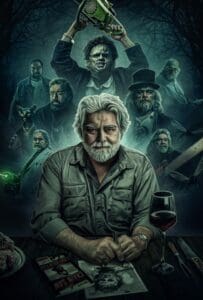
MK: Robert Englund and Kane Hodder both have their own feature length documentaries already (I thought of mine before theirs were ever produced). [Oops! – LAC]
When Gunnar was alive, I joked about making a doc about him, as he was such a worldly, intelligent and interesting person. Aside from being a published writer, he was a poet, documentarian, writer, and producer, a computer whiz, a whiskey lover, a sailor, a crab fisherman AND an actor… when he felt like it.
He kept his private life very private and his “industry” life the way he wanted it… on HIS own terms. He would have probably said the same thing if he was still with us: “Why make a documentary about a guy who played Leatherface once?” He was way more than that. He did SEVERAL indie movies in Michigan in the late 70’s that made him say he’d never act again.
Once he started doing the convention circuit in the mid-eighties, meeting fans and signing pictures and the like, he was sucked back in. He agreed to do my first feature as he was finishing up another Michigan-based production, Gary Jones’ Mosquito. I ended up poaching four or five actors from Mosquito for Hatred of a Minute.
Fans adored Gunnar. His friends and colleagues loved him, and he led a pretty interesting and amazing life outside of doing B-movies in the Midwest. Top it all off with being in one of the most infamous horror movies ever, and that intrigued me. If there were a Mount Rushmore of modern horror icons, it would be Jason, Freddy, Michael Myers, and Leatherface carved in that mountain.
Horror fans will enjoy the doc about an icon who embraced and revered his fans. I think people who aren’t horror fans will enjoy the film as well… seeing a pretty laid-back, well-spoken, funny intellectual who had many talents and life experiences… a man who played one of the most recognizable film villains known around the world… and what other accomplishments he made and how he didn’t need to be in the movie business. He did it on his terms, like he did everything. That’s compelling.
He was also a friend who championed me and my career back when I was first starting out. He deserves the love letter that this documentary will be.
10. Access! How can people learn more about you, view your films, purchase your films, and generally get access to your world (please provide any links you want to share)?
MK: My socials: www.facebook.com/filmmike, www.instagram.com/michael.kallio
For shorts, music videos, trailers, and more: www.youtube.com/darkallio, www.vimeo.com/michaelkallio
Websites in progress: www.michaelkalliofilms.com, www.modernclassicpictures.com (my production company)
The Scout is on Tubi, Roku, Google Play and DVD, (with behind-the-scenes, commentary by cast and crew and Q&A from Screamfest 2021)
Trailer:
Mutant Swinger from Mars (a 1950s sci-fi/horror spoof) is on Tubi and Amazon and will also be released on Blu-ray in a special edition in 2024.
Trailer:
Also check out these pages for my upcoming production Rednecks vs. Aliens!
Or Facebook: https://www.facebook.com/rednecksvsaliens
About the Filmmaker
Born at an early age in Detroit, Michigan, Michael started making Super-8 movies at 6 years old after seeing Star Wars. In his early 20’s, he made his first feature film, Hatred of a Minute, a psychological thriller starring himself and Gunnar “Leatherface” Hansen and produced by Bruce Campbell. A second feature followed, Mutant Swinger from Mars, a 50’s sci-fi spoof inspired by Ed Wood and the Jerry Lewis film The Nutty Professor, which featured the acting debut of The White Stripes front man and guitarist Jack White. He has had his hand in every aspect of the film industry, working not only as a writer, director, producer, actor, and editor but also a special effects artist, a production designer, and an art director. He is currently doing two documentaries. One is on his late friend and colleague Gunnar Hansen, Dinner with Leatherface. The other focuses on the local Southern California band The Radioactive Chicken Heads and is tentatively titled Cluckumentary. Recently he directed back-to-back-to-back features, the found-footage/slasher film The Scout, another atmospheric horror film, Inner Demons, and An LA Christmas Story, a Christmas rom-com on which he is wrapping up post-production. Sometimes, he writes stuff, too. He has an essay about the film Evil Dead 2 in Volume 3 of My Favorite Horror Movie: Scream Warriors and writes weird poetry. He is also currently working on a sci-fi/horror/comedy entitled Rednecks Vs. Aliens, among other film and television projects. He hangs out with his wife, Jessica, and their fur baby/dog, Buddy.
